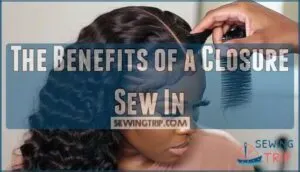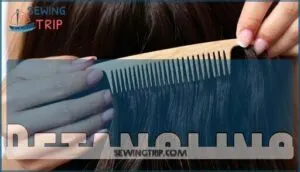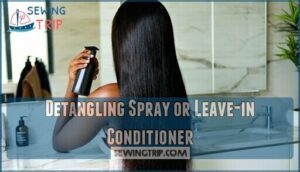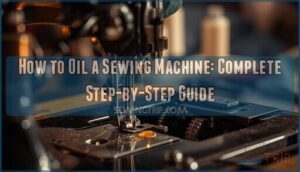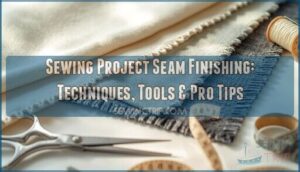This site is supported by our readers. We may earn a commission, at no cost to you, if you purchase through links.
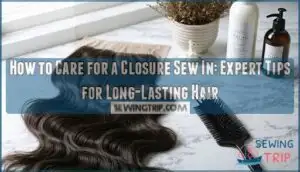
Wash weekly with sulfate-free shampoo, working from scalp to ends without rough scrubbing. Always detangle from bottom to top using a wide-tooth comb on damp hair with leave-in conditioner.
Sleep with a silk bonnet or pillowcase to prevent friction and tangling. Avoid excessive heat styling and use heat protectant when necessary.
Keep your hands out of your hair throughout the day – constant touching leads to matting and premature wear. Choose moisturizing products specifically designed for extensions, as they’re more delicate than your natural hair.
With proper technique, your closure can maintain its fresh appearance for months while protecting your natural hair underneath.
Table Of Contents
- Key Takeaways
- What is a Closure Sew In?
- The Benefits of a Closure Sew In
- How to Properly Care for a Closure Sew In
- Common Mistakes to Avoid With Closure Sew Ins
- Tips for Extending The Lifespan of a Closure Sew In
- Recommended Products for Caring for a Closure Sew In
- Frequently Asked Questions (FAQs)
- Conclusion
Key Takeaways
- Wash weekly with sulfate-free shampoo – You’ll keep your closure fresh without stripping natural oils that protect the delicate lace and hair fibers.
- Sleep with silk protection every night – You’ll prevent friction damage and tangling by using a silk bonnet or satin pillowcase instead of rough cotton materials.
- Detangle gently from ends upward – You’ll avoid lace tearing and breakage by using wide-tooth combs on damp hair with leave-in conditioner, never forcing through knots.
- Apply heat protectant before styling – You’ll shield your investment from thermal damage and extend its lifespan by using protective sprays and minimizing heat exposure.
What is a Closure Sew In?
A closure sew-in is a protective hairstyle that uses a small piece of lace with hair attached to cover the crown area where your natural hair parts.
This technique creates a seamless blend between your natural hair and extensions, giving you the freedom to style your hair in multiple ways while keeping your own hair protected underneath.
Transform your natural hair into a versatile masterpiece while keeping it safely protected underneath.
Lace Frontals
Lace frontals offer maximum styling versatility but require careful frontal application and precise blending techniques.
These larger pieces cover your entire hairline, allowing you to create natural-looking baby hairs and various parting styles.
However, their size demands expert installation and diligent frontal maintenance. You’ll need to cleanse the lace regularly and consider glue alternatives for sensitive skin.
Replace your frontal every 4-6 weeks to prevent lifting and maintain that seamless blend with your natural hair, ensuring a long-lasting and natural-looking result.
Closures
While lace frontals cover your entire hairline, closures offer a more targeted approach to your closure sew in needs.
These smaller pieces typically measure 4×4 or 5×5 inches and focus on creating a natural part in specific areas.
Closure Materials matter substantially for your lace closure sew in success.
Knot Bleaching helps the hair appear to grow naturally from your scalp, while Closure Density affects how full your hair looks.
Quality Parting Options let you switch between middle and side parts, and well-crafted Baby Hairs complete the realistic appearance.
For a seamless look, consider how to achieve a strong and concealed finish when dealing with any potential damage.
Key benefits of closures include:
- Seamless blending with your natural hair texture and color
- Versatile styling options for different looks and occasions
- Scalp protection while maintaining access for proper hair closure care
- Cost-effective alternative to full lace frontals for targeted coverage
Proper closure installation and consistent sew in hair care will maximize your investment’s longevity.
The Benefits of a Closure Sew In
You’ll love how closure sew-ins give you the freedom to switch up your look while keeping your natural hair protected and healthy.
These versatile protective styles offer realistic scalp appearance, endless styling options, and shield your hair from damage caused by heat and chemical treatments.
Versatility in Styling
While closures can’t create ear-to-ear styles like frontals, they still offer impressive versatility in hair styling.
You can achieve stunning side parts, sleek ponytails, and chic half-up styles that showcase different texture choices and color options.
Smart styling techniques and quality styling products help maintain hairstyle longevity while keeping your closure sew in looking fresh and natural.
Protection for Natural Hair
Beyond styling versatility, your closure sew in acts as a protective shield for your natural hair.
This protective styling method prevents chemical damage while promoting healthy growth and thinning prevention. Your scalp health improves as the closure reduces manipulation of your natural texture.
- Hair Protection: Creates a barrier against environmental stressors and daily handling
- Growth Promotion: Allows natural hair to rest and flourish underneath
- Chemical Damage Prevention: Shields hair from harsh treatments and processing
- Scalp Health Maintenance: Reduces tension and breakage through proper sew in maintenance
Realistic Scalp Appearance
Your closure’s realistic appearance depends on choosing quality materials and proper customization.
Swiss lace with bleached knots creates the most natural hairline, while density matching guarantees seamless blending with your natural hair.
One must also consider that improper installation can lead to traction alopecia concerns.
| Feature | Poor Quality | High Quality |
|---|---|---|
| Lace Material | Thick, visible lace | Thin Swiss lace |
| Knot Bleaching | Dark, obvious knots | Properly bleached knots |
| Part Customization | Generic straight part | Customized to face shape |
| Density Matching | Mismatched thickness | Matches natural hair density |
| Scalp Concealer | No color matching | Professional tinting |
Professional lace tinting and part customization transform your weave closure into an undetectable masterpiece.
When you invest in proper closure maintenance tips and lace closure cleaning, your realistic scalp appearance will fool even the closest inspection.
How to Properly Care for a Closure Sew In
You’ll need to follow a proper care routine to keep your closure sew-in looking fresh and natural for weeks.
The right maintenance approach protects both your investment and your natural hair underneath.
Washing and Conditioning
Proper sew in washing starts with sulfate-free shampoos and lukewarm water to protect your closure cleaning routine. Begin by gently scrubbing the closure with diluted shampoo, focusing on scalp care beneath the installation.
Follow with deep conditioning, allowing the product to penetrate for several minutes. Thorough rinsing prevents buildup, and air drying maintains the closure’s integrity while protecting your natural hair underneath.
To keep your sew-in fresh, consider a weekly washing schedule. Use a scalp applicator bottle to reach braids under the closure effectively.
- Apply conditioner from mid-length to ends, avoiding the lace base area
- Rinse with cool water as the final step to seal cuticles and reduce shedding
- Section hair while wet to guarantee even drying and prevent matting
- Pat gently with microfiber towels instead of rubbing to minimize friction damage
Detangling
Anyone can master the art of detangling with the right approach. Start with a wide-tooth comb or quality detangling brush, working from ends upward to prevent matting.
Gentle brushing protects your closure sew in from unnecessary stress. Sectioning hair makes the process manageable, while detangling sprays provide slip for stubborn knots.
Never force through tangles—this damages both the lace and hair fibers. Use your fingers for problem areas, applying light pressure throughout.
This careful hair detangling routine maintains your hair weave maintenance schedule and keeps strands smooth. Consistent gentle handling preserves your investment while preventing costly repairs.
Consider using detangling spray products for added ease.
Nighttime Care
Each night before bed, wrap your closure sew in with a silk scarf or satin bonnet to prevent tangling and friction.
These smooth fabrics let your hair glide without catching or pulling.
You can also braids hair loosely or create a gentle loose ponytail to minimize movement while sleeping.
Invest in a satin pillowcase for extra protection against moisture loss and breakage.
The slippery surface reduces friction that can damage your weave’s delicate lace base.
Avoid letting your closure directly contact rough cotton pillowcases.
Consider using a quality silk bonnet for sew-ins.
Proper nighttime care keeps your hair weave maintenance routine simple.
You’ll wake up with your closure style intact, ready for gentle detangling instead of wrestling with knots and tangles.
Protection From Heat and Sun
Heat styling and sun exposure can seriously damage your closure sew in and natural hair underneath.
Always apply heat protectant spray before using styling tools to shield your extensions from thermal damage.
When spending time outdoors, wear hats or scarves to prevent UV damage that can fade color and weaken hair fibers.
Your scalp also needs protection from harsh sun rays to maintain healthy hair growth and prevent damage from UV damage.
Choosing The Right Products
Beyond protecting your closure from heat and sun damage, selecting the right hair care products makes all the difference in maintaining your investment.
Smart product selection keeps your closure looking fresh and natural:
- Sulfate-free shampoos – Choose gentle formulas like OGX Nourishing to prevent dryness and fiber damage
- Lightweight conditioners – Use products without heavy silicones that won’t weigh down your closure
- Heat protectants – Apply before any styling to shield hair fibers from thermal damage
- Scalp oils – Keep your natural scalp moisturized with targeted treatments between tracks
- Edge control – Maintain clean edges with alcohol-free products designed for delicate areas
Match closure products to your hair’s texture and porosity. For a seamless look, consider the lace color options.
Your hair care routine should include items specifically formulated for extensions. Quality hair protection products extend your closure’s lifespan substantially.
Common Mistakes to Avoid With Closure Sew Ins
Even the most careful hair enthusiasts can unknowingly damage their closure sew-ins through common oversights.
Learning what to avoid will help you maintain your investment and keep your hair looking flawless for weeks.
Using Harsh Products
Harsh products can destroy your closure sew in faster than you’d expect. Sulfate-heavy shampoos and alcohol-based styling products strip natural oils, causing dryness and premature deterioration.
Smart product choices protect your investment and maintain healthy hair.
- Product Ingredients: Read labels carefully, avoiding sulfates, parabens, and harsh alcohols
- Chemical Damage: Strong formulas weaken lace fibers and cause color fading over time
- Natural Alternatives: Choose gentle, plant-based cleansers that nourish without stripping
- pH Balance: Select products with balanced pH levels to maintain hair’s natural acidity
- Product Buildup: Heavy creams and gels accumulate, weighing down your closure sew in
Rough Handling and Brushing
Many people unknowingly damage their closure sew in through aggressive brushing and rough handling.
Your delicate lace closure requires gentle brushing with wide-tooth combs to prevent lace tearing. Start detangling at the ends, working upward in small sections. Avoid tugging or forcing through knots, as this causes knot damage and product buildup around tangles.
| Do This | Not This | Why It Matters |
|---|---|---|
| Use wide-tooth combs | Fine-tooth brushes | Prevents lace tearing |
| Start at hair ends | Begin at roots | Reduces knot damage |
| Work in small sections | Brush entire closure at once | Minimizes stress on lace |
| Gentle, slow strokes | Quick, forceful brushing | Maintains closure integrity |
Neglecting Proper Maintenance
Skipping your closure sew in maintenance routine creates a domino effect of problems that’ll leave you regretting your choices.
Product buildup accumulates on your scalp, creating the perfect breeding ground for scalp issues and that unmistakable sew-in odor nobody wants.
Your hair closure maintenance becomes a nightmare when tangled hair takes over, and lace deterioration follows close behind.
Consistent sew in closure care prevents these disasters from happening.
Daily attention to your sew in aftercare routine keeps everything fresh and manageable.
Hair maintenance isn’t optional—it’s essential for preserving your investment and keeping your style looking flawless week after week.
Applying Too Much Tension or Stress
Why risk damaging your closure sew in with excessive tension? Applying too much stress causes hairline damage, weft strain, and traction alopecia that can permanently harm your natural hair.
- Handle your closure gently during styling sessions
- Avoid over-manipulating the delicate lace hairline area
- Choose loose, low-tension hairstyles that won’t cause stress
- Allow hair to fall naturally without forced positioning
- Give your edges recovery time between sew-in installations to prevent traction alopecia.
Tips for Extending The Lifespan of a Closure Sew In
Your closure sew-in can last much longer when you follow the right maintenance routine. With proper care techniques, you’ll protect your investment and keep your style looking fresh for weeks.
Protect your investment—proper care keeps your closure looking salon-fresh for weeks longer.
Regular Maintenance and Touch-ups
Your closure sew in thrives with consistent attention, much like tending a garden. Schedule professional touch-ups every 6-8 weeks to maintain ideal appearance and hair health.
| Maintenance Task | Frequency | Purpose |
|---|---|---|
| Scalp Moisturizing | 2-3 times weekly | Prevents dryness and irritation |
| Stitch Tightening | Every 4-6 weeks | Maintains secure attachment |
| Edge Maintenance | Weekly | Keeps hairline looking natural |
Between salon visits, inspect your weave sew in care routine for loose threads requiring lace repair. Professional reinstallation frequency depends on your hair’s growth rate and lifestyle. Regular conditioning prevents matting while gentle washing preserves the closure’s integrity. Monitor your scalp’s condition and address any concerns promptly to maximize your hair closure maintenance investment.
Using Protective Styling
Protective styling keeps your closure sew in healthy longer.
Choose low-tension styles like loose braids or ponytails that won’t stress the lace. Regular braid maintenance prevents matting and breakage.
Consider wig alternatives when you need a styling break. These gentle approaches support natural hair growth underneath while maintaining scalp health.
Your closure sew in will thank you for the TLC.
Avoiding Excessive Heat and Styling
Heat styling can make or break your closure sew-in’s lifespan. Smart styling choices keep your investment looking fresh longer. Always apply heat protectant before using any hot tools—this simple step prevents damage and breakage.
Lower your styling frequency to give hair a break between sessions. Consider these gentle styling approaches:
- Use heatless options like braids or rollers for texture
- Choose low-tension styles that don’t pull on your hairline
- Apply heat protectant generously before every styling session
- Stick to gentle styling techniques with wide-tooth combs
Your hair styling tips should prioritize protection over perfection. Heat protection isn’t optional—it’s your sew-in’s best friend for longevity.
Proper Storage and Care When Not Wearing
Between washes, proper storage keeps your lace closures looking fresh longer.
Start with thorough closure cleaning using sulfate-free shampoo, then detangle gently with a wide-tooth comb.
Once completely dry, place closures in protective bags or on a wig stand for knot preservation.
Regular maintenance visits are also essential for longevity.
Store in cool, dry areas with humidity control to prevent mold.
These hair care basics protect your hair extensions investment and maintain their natural appearance.
Recommended Products for Caring for a Closure Sew In
Choosing the right products is essential for maintaining your closure sew-in’s quality and extending its lifespan.
The products you use can make the difference between a closure that looks fresh for weeks versus one that becomes damaged and unmanageable, which is why selecting the appropriate items is crucial.
Shampoo and Conditioner
You’ll want to invest in quality sulfate-free shampoos and moisturizing conditioners specifically designed for extensions.
These gentle formulas clean without stripping natural oils that keep your closure looking fresh and healthy.
- SheaMoisture Wig & Weave Residue Remover – Deep cleanses with tea tree oil and aloe vera
- OGX Coconut Milk Shampoo & Conditioner – Provides creamy, nourishing care without buildup
- Pantene Pro-V DreamCare – Rejuvenates dull extensions while adding manageability
- TPH by Taraji – Formulated specifically for scalp and natural hair during sew-ins
Focus your washing frequency on every 2-3 weeks, applying product gently to avoid damaging delicate lace.
Proper drying methods and consistent hair care routines will maximize your closure’s lifespan.
Detangling Spray or Leave-in Conditioner
Detangling spray and leave-in conditioner become your closure sew-in’s best friends, preventing breakage during combing.
Apply these products after washing, focusing on mid-lengths and ends where tangles form most. Start detangling from the bottom, working upward with gentle strokes to maintain your investment’s longevity.
To further reduce friction, consider using products that reduce static electricity.
| Product Type | Key Benefits | Application Method |
|---|---|---|
| Detangling Spray | Reduces friction, eases knots | Spray on damp hair before combing |
| Leave-in Conditioner | Moisturizes, protects lace | Apply to ends, avoid scalp area |
| Lightweight Formula | Prevents buildup, maintains bounce | Use sparingly for best results |
Heat Protectant Spray
Shield your closure sewin with thermal-defense formulas containing silicones and proteins.
These spray ingredients create protective barriers against styling damage while maintaining moisture balance.
Essential Application Techniques:
- Mist damp hair before blow-drying or flat ironing
- Focus coverage on mid-lengths and ends of hair extensions
- Wait 30 seconds before applying direct heat to hair weaves
Quality heat protectants like TRESemmé Platinum Strength safeguard against temperatures up to 450°F, making them perfect hair care tips for maintaining your investment.
Silk or Satin Bonnet or Pillowcase
The right fabric makes all the difference in protecting your closure sew-in overnight.
Here’s your material comparison guide for ideal nighttime care:
- Silk pillowcases offer superior friction reduction and moisture retention compared to cotton alternatives
- Satin bonnets provide complete hairstyle preservation while staying securely positioned during sleep
- Bonnet alternatives like silk scarves work when traditional bonnets feel uncomfortable or restrictive
- Hair care maintenance improves dramatically with consistent use of either silk or satin materials
Both fabrics prevent tangles and breakage through reduced friction, extending your closure’s lifespan substantially.
Frequently Asked Questions (FAQs)
Why do you need a closure sew-in?
Think of closure sew-ins as your hair’s protective shield.
You’ll get added length, volume, and versatility while keeping your natural hair safe from damage, heat, and chemical treatments that cause breakage.
Are sew-ins with lace closures a good idea?
Yes, sew-ins with lace closures are excellent for protecting natural hair while achieving versatile, realistic styles.
They offer seamless blending, natural parting options, and styling freedom without compromising your hair’s health, which includes natural parting options.
How do you sew a closure piece?
Position your closure on the braided base, securing it with needle and thread using small, tight stitches along the perimeter.
Sew through both the closure’s edge and underlying braids, maintaining even tension throughout for secure attachment.
How long does a closure sew in last?
Like a faithful friend who stays by your side, a closure sew-in typically lasts 6-8 weeks with proper care.
You’ll need professional removal and reinstallation to maintain hair health and prevent damage.
How long does a lace closure sew-in last?
A lace closure sew-in typically lasts 6-8 weeks with proper care. You’ll need professional removal and can reinstall the same closure 2-3 times before replacement.
How do you sew a lace closure?
Threading that closure onto your braids is like performing surgery with a needle and thread—precision is everything.
First, position your closure perfectly over your cornrowed base.
Then, carefully sew around the perimeter using small, tight stitches to secure it seamlessly.
How long should a closure sew-in last?
A closure sew-in typically lasts 6-8 weeks with proper care. You’ll need professional removal and reinstallation after this period to maintain healthy hair and prevent damage from overtightening.
How to maintain your closure?
Wash your closure every 2-3 weeks with sulfate-free shampoo, deep condition regularly, minimize heat styling, sleep with satin protection, and gently detangle to prevent damage.
Can you wash your hair with a closure sew-in?
Yes, you can absolutely wash your hair with a closure sew-in.
Use sulfate-free shampoo every 1-2 weeks, gently massage your scalp, rinse with lukewarm water, and air-dry to maintain the closure’s integrity.
How to deal with an itchy closure sew-in?
Gently cleanse your scalp with diluted shampoo and cool water. Apply witch hazel or scalp tonic to soothe irritation. Moisturize with lightweight oils, avoiding the lace base completely.
Conclusion
Proper maintenance extends closure sew-ins by up to 400% longer than neglected ones, making your investment worthwhile.
Following these care techniques guarantees your closure maintains its natural appearance while protecting your hair underneath.
Remember that how to care for a closure sew in determines both longevity and overall satisfaction.
Consistent gentle handling, quality products, and protective measures keep your style fresh for months.
Your dedication to proper care pays off with beautiful, healthy-looking hair that boosts your confidence daily.
- https://www.healthline.com/health/hair-oiling-benefits-oil-and-how-to
- https://www.aad.org/public/diseases/hair-loss/causes/hairstyles
- https://www.styleseat.com/blog/how-to-wash-a-sew-in/
- https://www.hairextensionsinc.com/blog/how-long-do-sew-ins-last/
- https://wealthyhair.com/beginners-guide-on-how-to-achieve-maintain-the-perfect-closure-sew-in-with-straight-hair

